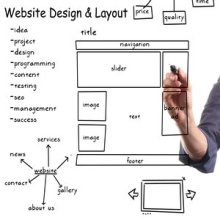Design and Layout of a Website

The design and layout of a website may be appealing but if it is not SEO-friendly, it cannot achieve higher rankings in search engine result pages. The search engines cannot interpret the content just like us and the visitors; a webpage may not look the same to a search engine as it looks to you. So, keep the following guidelines in mind before you start thinking about the design and layout of a website.
1) Keyword Placement
You should use the targeted keywords and phrases at the right places throughout the site, i.e. body text, headlines, headers, meta description, links, etc. Proper keyword placement is important for every page but it is more important on the home page as it is a gateway and introduction to the rest of the pages of your site. Also, use proper words for links; instead of using “see more”, “read more” or “click here” use the words that describe the link itself.
2) Navigation
The navigation must be user-friendly so that users can easily find the desired information in less time, i.e. moving from one step to another step should be simple and quick.
Some of the useful practices to optimize your site are;
- The primary navigation should be at or near the top of your page.
- Add navigation options in the footer of web page.
- Add breadcrumb on every page to make users aware of their navigation path.
- Add a search box near the top of your page to enable users search by keywords.
- Offer limited navigation options on a page and limited steps in the navigation.
- Don’t modify the website template in every category as it could make the navigation difficult for the users.
3) URL’s and Filenames
URL should be SEO optimized so that search engine can easily indentify it. There are a number of ways to optimize a URL such as;
- Incorporate keyword in the URL so that it could clearly tell what is on the page
- Minimize its length to make it easier for the users to copy and paste
- Don’t use URLs that contain random letters or numbers
And to optimize the filenames you can add relevant keyword in the filenames of uploaded items, e.g. media, html, documents, etc. Also, you should use hyphen (-) instead of underscores, spaces or plus sign to separate words in the URL.
4) Images
Website images are an important aspect of SEO and should be optimized for faster loading and search engine visibility. Some of the practices to optimize images are;
- The size of images should be small, i.e. 30 ?100 kb size and 72 dpi resolution are considered optimal for website images.
- Images should be placed in context to the information on the pages, i.e. there should be relevant content around an image.
- Use proper alt tags for the images as the search engine can only see words, not the images. So, instead of using alt tags like “image” or “screenshot” use a phrase that contains a keyword or describes the image.
5) Simplicity
Visitors come to your site to complete some task or to find specific information, so avoid unnecessary design elements that could make it harder for the visitors to accomplish a task or find the information. Some instructions to enhance simplicity in a website are;
- Don’t add too many colors, i.e. according to SEO experts use maximum of five colors in your website.
- Choose easily readable typefaces and use maximum of three different typefaces and maximum of three different sizes for each typeface.
- Add graphics only if they help users perform a specific action.
- Add suggestion plugins to help users find pages with specific information.
- Avoid horizontal scroll and pop ups as they could annoy the users.
